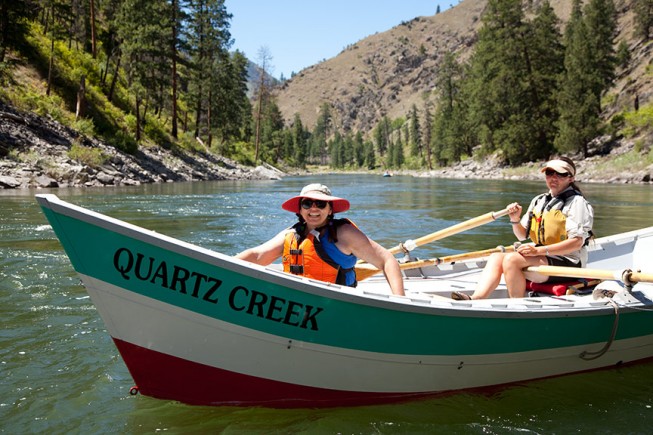How Does a Dory Get its Name?

When you first lay eyes on a dory, you can’t help but notice the beauty of these finely crafted, river vessels. Hand-painted in assorted color schemes to match the natural hues of river canyons throughout the West, each dory also has something else that will catch your attention—an individual name, painted prominently on its bow for all to see.

But what’s in a name? When it comes to a dory, more than you might realize at first glance.
First, you have to know a little bit about a man named Martin Litton. A crusader for the protection of many rivers, national monuments and forests, Litton first floated the Colorado River in 1955. Humbled by its beauty and grandeur, he fought to save the river from being dammed. Several years later, when the Grand Canyon rafting industry was taking off, Litton decided to open his own commercial guiding company. And when everyone else was transitioning into the modern era of rubberized rafts and motor rigs, Litton was determined to run dories (a nod to the past and early river expeditions of the late 1800’s).
He launched Grand Canyon Dories in the summer of 1969 and to his surprise, and everyone else who was guiding trips on the river at that time, the dories were a hit. Soon, the devoted environmentalist and dory pioneer would need a fleet of boats to accommodate the growing interest in Grand Canyon dory trips. It was at this point that Litton started a ritual.
According to Kevin Fedarko’s book, The Emerald Mile, Litton “inaugurated a tradition of naming every craft after a natural wonder that, in his view, had heedlessly been destroyed by the hand of man—‘to remind us of places we’ve destroyed without any necessity,’ he would bark to anyone who inquired, ‘so that maybe we’ll think twice before we do it again.’” Litton, a longtime advocate for preserving our most sacred and wondrous natural places, wanted to make a statement.
How a dory gets its name is simple, yet significant. And still today, as OARS carries on Litton’s legacy of Grand Canyon Dories, each hand-crafted boat is bestowed with a unique identity to remind us all of the special places we’ve lost.
Every Dory Has a Story…

HIDDEN PASSAGE
Hidden Passage, named after its nearly invisible entrance by early explorer John Wesley Powell, was “a passage to a living canyon in the desert.” This lost treasure still evokes wonder in what lies in Glen Canyon—the 170-mile natural paradise legendary for its secret grottoes, waterfalls, beautiful ravines and isolated side canyons like Hidden Passage before it was flooded by Lake Powell upon the completion of the Glen Canyon Dam in 1963. Edward Abby, a powerful environmental writer and one of the few lucky people who got to see Glen Canyon before it was flooded, called the landscape “an Eden—a portion of earth’s original paradise.” Source: Colorado River Before Construction of Dam

QUARTZ CREEK
Logging near Idaho’s North Fork of the Clearwater River began to peak at the start of WWII, and continued through the years, creating a need for more infrastructure. As a result, poorly placed roads and river camps were established along the Clearwater’s tributaries to harvest the vast stands of timber in the area. Hardest hit throughout this time was Quartz Creek. Too many roads too close together caused ample amounts of slides and washouts. The worst of these slides shoved 500,000 tons of dirt, debris, and rock—enough to fill 30,000 dump trucks—onto the road and into Quartz Creek, plugging the creek with a dam that was two city blocks wide, six stories tall, and topped by school bus-sized-boulders. The beautiful tributary was scarred. Source: Clear cutting Northern Idaho
Sign up for Our Newsletter





